When talking about Murano, it is impossible not to think of glass! This beautiful island in the Venetian lagoon is world-famous precisely because of the art of its master glassmakers, who are capable of working with glass , producing exquisitely crafted artifacts.
Did you know that Murano has been a master of this art since the 13th century? But not only that! in the 15th century the Murano people created crystal and later became the most sought-after and appreciated mirror makers in all of Europe!
In short, it is unthinkable to visit Venice and the lagoon without carving out a day to discover this precious and historic craft! Do you want to know how the technique has evolved over the centuries? Are you curious to see with your own eyes the master glassmakers at work? Read on and I will give you all the information you need!
Before we go any further, however, let me give you a tip: booking in advance online allows you to get numerous benefits, such as the accompaniment of an expert guide or the possibility of skipping the lines.
Not to mention that you can secure at a bargain price the opportunity to visit both the glass museum and a demonstration of the art of glassblowing, perhaps right in the former Cathedral of St. Clare!
Trust us! Book your organized tour and don’t miss this unique opportunity, where past and innovations meet to discover a piece of Italy’s history!
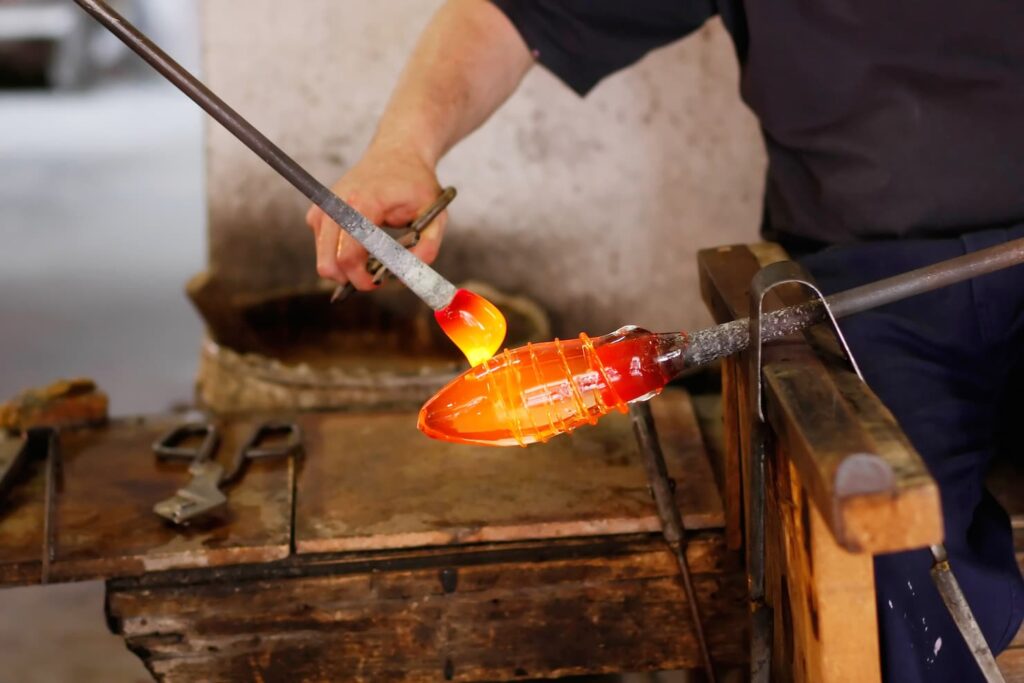
Bestseller ever
Murano and Burano: Guided boat tour from Murano with glassblowing factory
Immerse yourself in the streets of Murano and Burano and learn how the famous typical glass is made
Secure payment
Instant confirmation
Mobile ticket
The thousand-year history of Murano glass
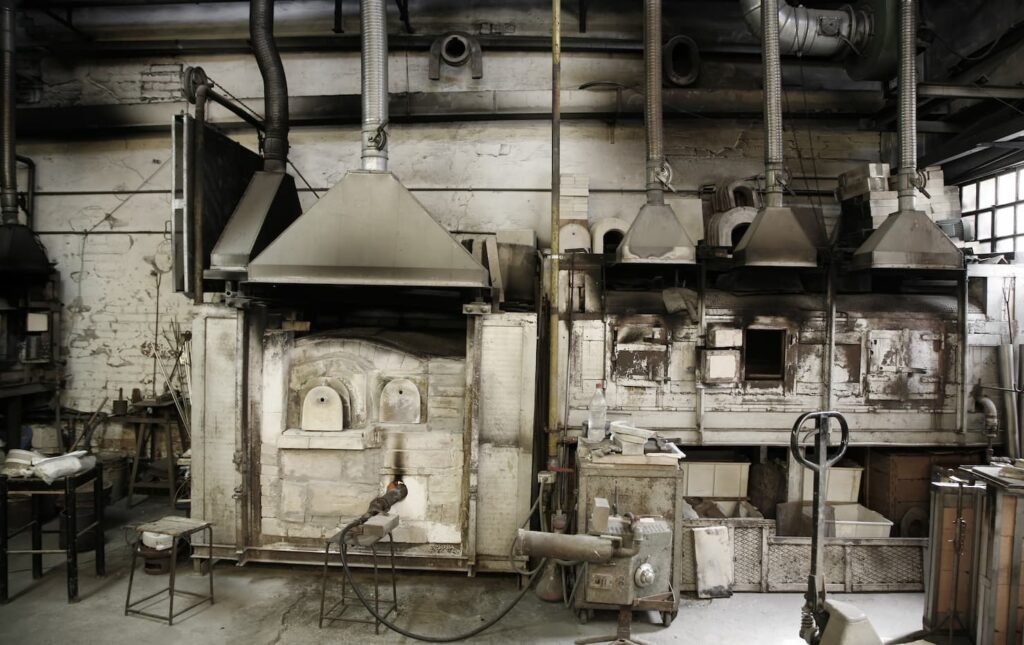
Antique glassmaking tools | ID 7411785 © Knud Nielsen | Dreamstime.com
This area has been an area of maritime trade since pre-Roman times, a junction between East and West: glass itself was one of the most sought-after commodities coming into the Mediterranean.
However, it was from the Middle Ages that the lagoon began to develop its art that would lead it to become one of the most prestigious areas in the world in these techniques.
This development was also influenced by the splendor of Venice, one of the maritime republics, and the Serenissima’s central role in the Mediterranean. However, the first glass-related phenomena are attested as early as 450, since many glassmakers from Aquileia took refuge here to escape the barbarian invasions.
The first artisanal glassworks in the area actually appear in Torcello, around the 7th century, and just before the year 1000 the first names of master glassmakers from Venice appear.
An important development of techniques occurred as a result of the encounter of glassmakers from Byzantium and the Middle East in general: in these areas, in fact, glassmaking had originated much earlier than in Italy and Europe in general.
Venice learned precisely from the glassmakers of the East the use of sodic glass, a particular composition suitable for hot working and which lends itself to the use of different colors, a typical feature of Murano techniques.
It was on this island in the lagoon that this particular working technique was developed: glassblowing. Murano’s master glassblowers blow into the glass, which, while still incandescent, is extremely malleable, making it possible to shape it to one’s liking.
And so, since the 13th century the island has been one of Europe’s leading centers in glassmaking! Do you want to know an incredible historical curiosity? Just think that Murano was so highly regarded for its glassworks that in 1291 the state decided to destroy the glassworks present in Venice precisely to acknowledge the island’s dominance and officially confer on it the historical authorship of this art.
Craftsmanship became so important to Murano that already a few years earlier, in 1271, the guild of glassmakers intervened to preserve the secrets of the typical techniques of its artisans: real strict and incredible rules!
In order to achieve its goal, the guild did not discount anyone: master glassmakers were not allowed to leave the city without permission, and if he did not return, his family was arrested. In the extreme, it was possible for the guild to hire an assassin to track down and eliminate the glazier.
Now it will be easier for you to understand why Murano is a unique place in the world when it comes to glassmaking and its techniques are truly inimitable!
During the Renaissance, then, schools were also born to train glassmakers to be placed in workshops with the masters: and this is what allowed Murano to perfect and pass on its technique.
The experience in the workshop was indeed very formative and allowed generations to constantly refine and innovate the technique, without ever forgetting the origins and traditions.
Murano, in fact, over the centuries has always been able to grow and adapt to changing demands: for example, in the 15th century, the ability to work with crystal was developed, just as in the 19th century, in more modern times, glassworks developed new, more contemporary techniques that are still used today, developing then a new focus on design, which is indispensable in today’s world.
The Murano Glass Museum shows just how past, present and future intertwine in this centuries-old art, where ancient glassblowing techniques meet new challenges of today, such as to ecological attention.
Have you looked at tickets for this attraction yet? Don’t miss your chance to see a demonstration of the process and discover its history!
Traditional techniques
First processing
There are many glassmaking techniques that have developed on Murano. Many of these were invented right on the island and have been refined from generation to generation. Read on if you want to learn more.
Adventurine
This is really one that was born here by the masters. We are around 1620 when Murano began experimenting with this technique involving the addition of tiny copper crystals.
The discovery was accidental on the part of the glassmakers so much so that the name comes from an important glassmaker of the seventeenth century, Giovanni Darduin, who stated that it was born more by “ventura than by science.” Hence, the name Avventurina was precisely born.
Crystal
Since the Middle Ages, this has been Murano’s pride and joy: a transparent, colorless glass obtained through purified raw materials. The secret of the master glassmakers is the selection of the materials used and mixed with decolorizing agents: the purity of the ingredients used makes crystal a product of the finest workmanship.
Invented in the Middle Ages, it was then copied throughout Europe only much later: thus Murano was the “cradle” of this particular type of glass. The blowing technique is very effective with this type of glass, producing very light objects for which, however, long processing is required.
FIligrana
This technique requires the use of rods that contain smooth threads of lactide or stained glass: the technique used is hot decoration.
Lactimo
This technique also originated in Murano, around 1450. The goal was to imitate Chinese porcelain, and in fact lattimo is a glass with an opaque white color, and opacifiers such as tin or lead lime were used to achieve it.
Blowing
This type of work is very old and revolutionized the world of glass: it dates back as far as the first century B.C., and thanks to it, glass production became faster and cheaper , thus favoring its development.
The technique originated in the East, in the area of present-day Syria, and consists of blowing through a blowpipe so that glass can be shaped. Later a metal rod was introduced, facilitating the work of the glassmaker, and this allowed for the further spread of this material.
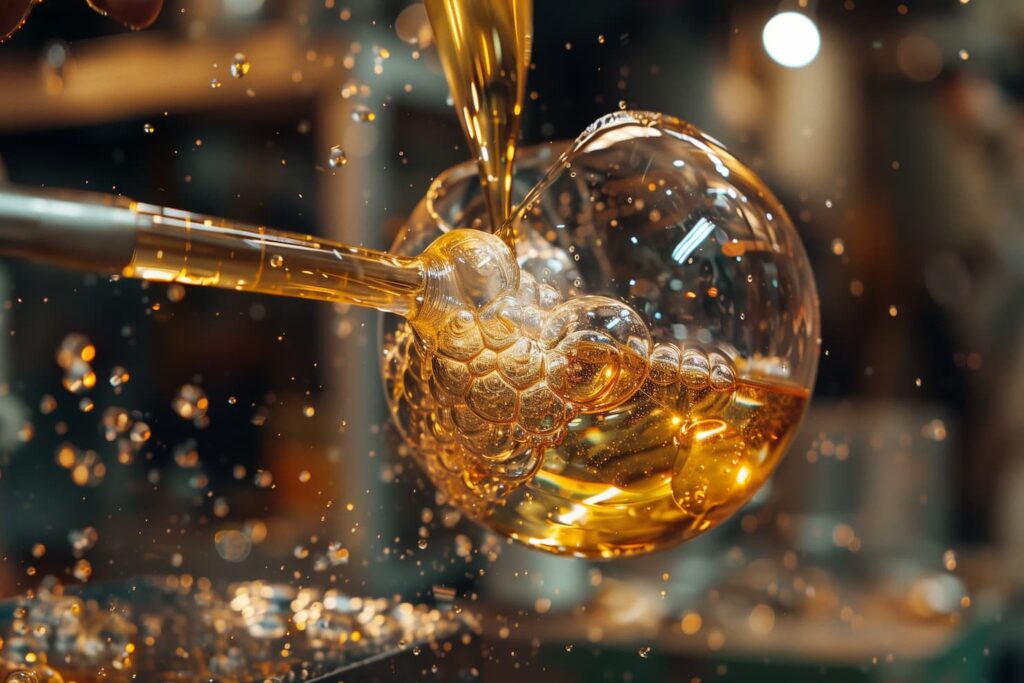
Closing a blowing process | ID 326042040 © Marija Starcevic | Dreamstime.com
Submerged
Another technique peculiar to Murano that consists of submerging a very thick blown glass in a crucible that contains glass of another color but equally thick. The effect that is obtained is really peculiar: the different glasses superimposed create extremely enchanting plays of color. The main use of this technique is for the production of vases.
Second processing
There are secondary processing techniques that occur at a later stage to further embellish artifacts. This is the case, for example, with enamel decoration through which colored compounds are used that are obtained through finely ground powders of opaque and transparent glass.
A brush is then used to embellish the surface of the glass, and then the decoration is put through a thermal cycle that softens it so that it adheres perfectly to the glass to which it had been applied.
However, second processes are many more and equally valuable and interesting than the first process. Below, here are other types.
Millefiori
This term refers to a cane that has some concentric glassy layers inside it that differ in shape and color, having some specific shapes such as a flower or a star.
The technique consists of imprinting the various shapes through the use of open molds, and then the pulling of the cane, even by tens of meters, takes place. To finish, the cane is cut into different parts called murrine.
If the cane used is pierced, it tends to produce beads; if, on the other hand, the starting cane is not pierced, dishes or bowls can be made from the murrines after the various sections have been juxtaposed and cast.
Grinding
A special technique that involves carving the glass in different stages of production using different wheels that are gradually finer and finer. To do this, a very coarse silicon carbide wheel is used in the first stage, while in the second stage a much finer one made of the same material is used again to finish the previous carving.
In the third stage, on the other hand, a wheel made of natural sandstone must be used, and then the wheel of the fourth and fifth stages must be used, which is made of cork impregnated by a mixture of pumice stone and water: in these latter parts of the process the engraving is polished.
When the work is finished, everything is cleaned with a cloth wheel moistened with cerium oxide and water, which allows the engraving to become shiny.
Mirror
The Venetian mirror became famous throughout Europe and originated during the Renaissance. To produce it, its workmanship consists of a sheet of glass partly coated with aluminum or silver capable of reflection in this way.
This object originated in the 12th century, but its great diffusion occurred a century later, and during the Renaissance the Venetian lagoon was unrivaled in this technique with the sole exception of Nuremberg.
The 16th-century technique was to use a very thin layer of an alloy that could reflect, such as mercury and tin, but in the 19th century production was perfected as a result of scientific discoveries and that type of workmanship is still used today.
The technique involves spraying a layer of aluminum or silver on the underside of the glass, thus producing a reaction; the opposite side of the sheet, on the other hand, is covered with a varnish that serves as protection.
Glass fusion
One of the oldest techniques that involves placing small, differently colored pieces of glass on top of a ceramic fiber plate and then fusing them in an electric furnace.
Thus, a single glassy fabric with different color shades is obtained, and the resulting glass is called a mosaic or murrina. If the process is repeated several times, a three-dimensional decoration can be obtained.
Murrine glass
This is also one of the oldest of the second-processing techniques involving the use of a glass plate obtained by welding together several pieces of colored glass.
The plate is then molded using a special refractory clay mold, and by modifying it again it is possible to give it the shape of vases.

Bestseller by far
Murano and Burano: Guided boat tour from Murano with glassblowing factory
Immerse yourself in the streets of Murano and Burano and learn how the famous typical glass is made
Secure payment
Instant confirmation
Mobile ticket
Historic furnaces: where to see them
If glass is the great protagonist of Murano, nothing would be possible if the splendid historic furnaces did not exist . These places are the real beating heart of what is a historic art, a tradition handed down through the centuries.
There are many glassworks and factories on the island where master glassmakers offer demonstrations of various techniques and fascinate millions of visitors each year by showing them how glass is worked.
To think of coming to Murano and not having this experience would be a really big mistake: watching the masters at work is truly enchanting and equates to being able to admire an artist at work!
Today’s master glassmakers are keeping up with the times: tradition meets the most modern tastes in design. In fact, at the end of the demonstration, you will be able to buy items produced and notice their extremely contemporary taste-you won’t be able to decide which one to choose to take home with you!
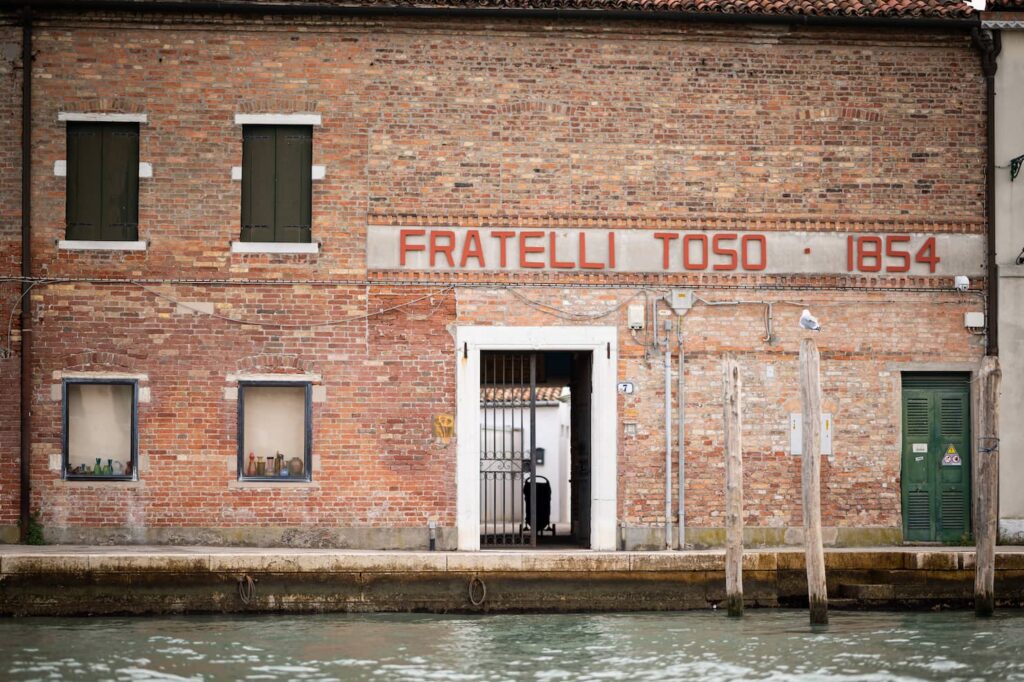
Toso Brothers Furnace, the oldest still in operation | ID 236506804 © Stefan Rotter | Dreamstime.com
Many of the most historic furnaces to visit are also well-known brands such as Salviati and Seguso. The oldest glassworks still in operation today is the Antica Vetreria Fratelli Toso, founded in 1854!
Many of the workshops are concentrated in the Fondamenta dei Vetrai, the typical island promenade where you can admire the main glassworks and the great masters at work.
Some of the most appreciated furnaces that I recommend arethe Colleoni artistic glassworks, located right in Fondamenta S. Giovanni dei Battuti 12 and that of Venini, a very well-known brand as well as one of the largest and most prestigious glassworks in the world!
However, once on site you can choose the one that inspires you the most: whatever you choose, I am sure you will not be disappointed with the demonstration.
Craftsmanship today: how Murano glass is being renewed
Throughout history, Murano glassmakers have always paid close attention to changes and challenges in the changing times. They have always been able to pay attention to changing fashions and tastes, often even inventing new products to surprise buyers.
Even today, glassworks are very attentive to market demand, and master glassmakers have become increasingly specialized and open to modern and innovative designs. The objects produced meet new, more modern tastes while maintaining the attention to detail and techniques developed since the earliest workings of centuries past.
A new issue that glassmakers today are very sensitive to is the ecological aspect: that is why in many furnaces they use recycled material to produce new glass thus merging innovation and sustainability.
One example is that of Edea Murano Chandelier, a glassworks specializing in the production of chandeliers, also using recycled material or using old and broken ones for new secondary production.
But that’s not all: a new project in which Ca’ Foscari University of Venice is collaborating with many glassworks aims to study how to design a circular economy in which to reuse glass waste so as to turn what is seen as a problem into an opportunity.

Bestseller by far
Murano and Burano: Guided boat tour from Murano with glassblowing factory
Immerse yourself in the streets of Murano and Burano and learn how the famous typical glass is made
Secure payment
Instant confirmation
Mobile ticket
What to buy: authentic glass vs. imitations
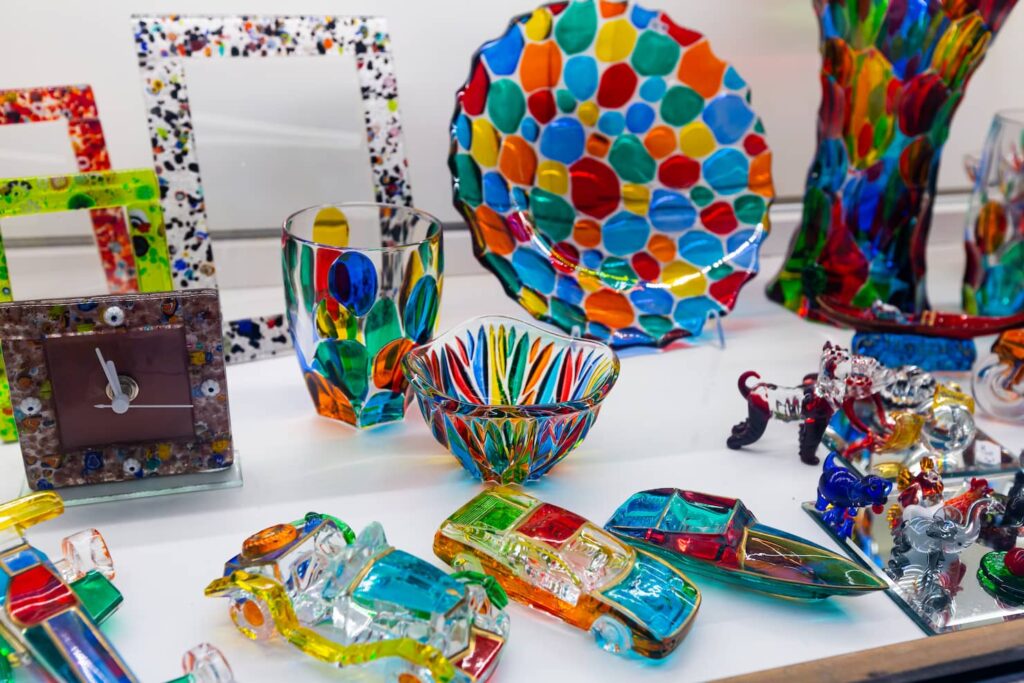
Murano glass souvenirs | ID 377614744 © Iakov Filimonov | Dreamstime.com
There are many cases of imitations of authentic Murano glass, but there are several signs that can help you distinguish it.It is essential to look closely at the distinctive details. In fact, authentic glass always bears a mark or signature of the master who produced it.
Also, always be wary of absolute perfection: the manual process of glassworks is characterized by a slight imperfection that is typical precisely of techniques that do not involve the use of machinery.
Often some glassworks also provide a certificate of authenticity, plus masters are wont to use gold or silver leaf as decoration. The presence of opacity could also be synonymous with a fake, since Murano glass is especially famous for its luminosity and lightness.
However, it would be unfair and unfortunate to buy glass passed off as authentic at a consonant price, but then end up with a fake. It is different, however, to knowingly purchase a copy, at a fair price, perhaps with the purpose of having a souvenir without incurring an excessive cost.
Murano glass, in fact, is considered a luxury item and therefore may be too expensive according to the ideas and availability of some.
In conclusion, however, I recommend if interested in purchasing a glass product to opt for an authentic artifact, perhaps of small size and at an affordable price:it will be a precious memento of an unforgettable visit, as well as a true piece of Italian art to keep in your home!
Frequently asked questions
Murano glass is famous because for centuries craftsmanship techniques have been handed down, as well as all the various discoveries and secrets of master glassmakers, experience gained throughout history. This has led to products of extreme quality and unique workmanship that have been appreciated worldwide since the Middle Ages.
To recognize true Murano glass, one must observe certain details that make it recognizable. Many products bear the signature of the master who made it or a mark, and still others have gold or silver leaf as a distinguishing mark. In addition, the workmanship of the glass can give clues: if it is too opaque it could be synonymous with imitation, since Murano glass is famous for its luster. Also, some noticeable imperfections are a good sign: they are a symptom of manual workmanship. Finally, also consider the price well: Murano glass is a luxury item and it is quite rare to underpay for it.
Glassblowing can be admired in Murano in many historic glassworks and furnaces, such as that of the Toso brothers, the oldest still in operation or the Colleoni artistic glassworks, one of the most popular with visitors as well as the Venina glassworks, one of the most famous in the world.
Glass is blown in many glassworks all over the island. The furnaces make Murano famous and are the beating heart of this part of the lagoon: workshops that over the centuries have always evolved and updated themselves by following fashions and refining techniques, even discovering new products, all the while staying true to their origins and learning from past generations.
Conclusions

“Murano Glass” sign | ID 41684761 © Adrian Gilfillan | Dreamstime.com
We have come to the concluding part of this article. I have told you everything you need to know about glassmaking, an attraction of the beautiful island of Murano.
We have seen together the history of this area that has always been linked to glassmaking; to continue, I have told you precisely the main techniques invented on the island and handed down from generation to generation, conquering all of Europe since the Middle Ages.
I then showed you which are the main glassworks and the most appreciated on the island, and then explained how you can recognize authentic Murano glass from imitations.
And have you visited Murano yet? Have you brought any glass artifacts with you or would you like to? Tell us yours in the comments!
Murano is an enchanting place where history, art, colors and innovation meet and blend together… just like glass! Don’t miss the opportunity to visit one of the most appreciated and magical places on the peninsula!
